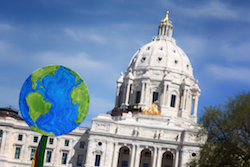SEJournal Online is the digital news magazine of the Society of Environmental Journalists. Learn more about SEJournal Online, including submission, subscription and advertising information.
TipSheet: Climate Marches Point Toward Local Climate Stories
This coming Saturday there is likely to be a climate march in your city or one nearby — a good chance to focus on how climate change will affect your area.
Turnout at the so-called “Peoples Climate March” April 29 is likely to be fueled by the mass turnout at the Science March last Saturday. While the main climate march will happen in Washington, D.C., there will be scores of “sister marches” in cities across the United States and around the world (find the one in your area at the march’s website).
A climate march itself is a news event, a chance to talk to people about their views on climate and usually to capture images of clever signs, outlandish costumes and interesting personalities.
But your local march may also give you a better idea of what groups are organizing and politically active near you, as well as issues unique to your region. And those issues will stay hot long after the signs are gone.
For instance, in the Southwest it may be drought. Along the Gulf Coast, it may be the loss of land to sea-level rise. In the Northwest and Rockies, it may be wildfire. In the Great Plains, it may be a crisis of irrigated agriculture. Along the Atlantic Coast, it may be hurricanes. In New England, it could be problems with fisheries or maple syrup.
Regional climate impacts better understood
Much more is known about these regional impacts today than a decade or two ago. But the political forces opposed to climate action (most notably the fossil fuel industry and anti-regulatory lobbies) even today work to suppress the information.
 |
| Earth sign at the Minnesota March for Science last weekend at the Capitol in St. Paul. Two climate marches will be held in nearby Minneapolis this Saturday, April 29. Photo: Lorie Shaull, Flickr Creative Commons. |
An example is the so-called “National Climate Assessment,” meant to study the impacts of climate change on the United States, especially the regional ones. It was once virtually un-published by the Bush administration. The Trump administration is expected to be equally hostile to it, even though it is required by law to be updated regularly.
The most recent one was completed and published in 2014. The next one is under way and expected to be published in late 2018. You can start exploring the 2014 report, including regional breakdowns, here. Climate Central did a summary of the report at the time.
You can still get a fair picture of regional climate impacts on the website of the U.S. Environmental Protection Agency. EPA even breaks it down to the state level. It might be prudent to download this material before it vanishes.
A branch of the National Oceanic and Atmospheric Administration does a quarterly regional climate update that can bring your focus more into the immediate timeframe.
States, cities step up over climate jurisdiction
Another way to localize the climate story is to put a spotlight on what your state and local jurisdictions are doing about climate.
Many states have climate action plans. One group that tracks these is the Center for Climate and Energy Solutions. Some states, operating on the assumption that climate change is inevitable, are planning how to adapt. The Georgetown Climate Center tracks these efforts. Another group tracking state efforts is the Center for Climate Strategies.
EPA has outlined what might go in a state action plan, but Trump and Congress could thwart state efforts to govern at the local level.
After the November 2016 election, however, mayors of some major cities sent Trump a message defying any potential effort he might make to block their action on climate. There is actually quite a lot that cities do (e.g., infrastructure) that can help with climate change. One group that acts as a hub for local climate efforts is known by the acronym ICLEI.
* From the weekly news magazine SEJournal Online, Vol. 2, No. 17. Content from each new issue of SEJournal Online is available to the public via the SEJournal Online main page. Subscribe to the e-newsletter here. And see past issues of the SEJournal archived here.













 Advertisement
Advertisement 



